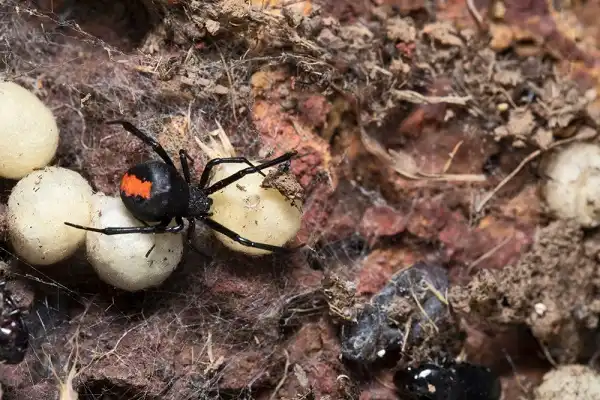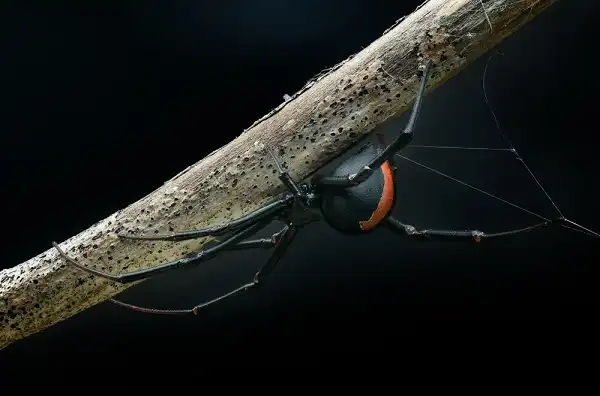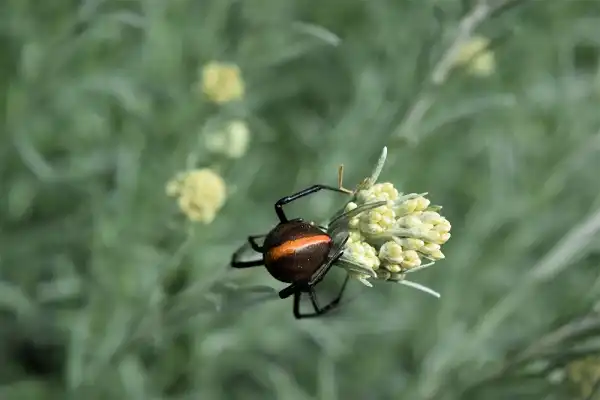Are you familiar with the Redback Spider? This Australian native is one of the most dangerous spiders that call our country home. The effects of a bite may range from aching muscles and excessive sweating to complete paralysis, and in the worst-case scenario may even prove lethal. But despite this fierce reputation, Redback Spiders are fascinating creatures that have adapted to their environment in remarkable ways. This post will focus on the unique habits, habitats, and biology of these incredible species, exploring how they have thrived in some truly surprising locations. So if you’re interested in learning more about these eight-legged predators then keep reading because there’s plenty to explore surrounding the Redback Spider!

Redback Spider Description
Let’s dive deeper into the physical characteristics and behavior of the Redback Spider. The most recognizable feature of the Redback Spider is its red hourglass-shaped mark on its black abdomen. However, not all individuals have this marking, and sometimes it might take on different shapes or colors, making it challenging to identify. Redback Spiders are not aggressive and prefer to escape if disturbed, but if cornered or attacked, they will bite.
Redback Spider Habitat
Redback spiders are distributed widely throughout Australia and are adapted to various environments, from forests and deserts to urban and suburban areas. They prefer dark, sheltered habitats and are usually found under logs, rocks, or garden furniture. They have been sighted in many places including sheds, garages and outhouses. These spiders have also been observed in open areas such as trees and bushes or on power poles. The Redback Spider’s web is unique and distinctive. It is made up of sticky silk threads and is usually located in sheltered areas. Spiders use their webs not only for trapping prey but also as a place for shelter and protection. In fact, Redback Spiders will often retreat to their webs when threatened, and their dark coloration helps them blend in with the surroundings and avoid detection.
Redback Spider Diet
The Redback Spider is known for its hunting technique that involves trapping flying insects in its sticky silk webs. However, the spider’s diet is not limited to insects alone. Redback Spiders prey on various small animals such as other spiders, crustaceans, and even small vertebrates like mice. The spider’s venom plays a crucial role in its hunting tactics. When an unsuspecting prey gets trapped in its web, the spider will bite it and inject venom to paralyze the prey. The venom also starts the process of breaking down the prey’s internal organs, making it easy for the spider to consume its meal. The Redback Spider’s diet is not limited to the immediate vicinity of its web either. These spiders are capable of actively leaving their webs to hunt for larger prey. They have been observed actively stalking and capturing small birds in their webs, demonstrating their predatory prowess and adaptability. Interestingly, the Redback Spider’s diet may also change according to seasonal availability. In areas where insects are less abundant, these spiders may shift their diet towards larger prey. This adaptation ensures the spiders can continue to thrive, even in areas with less food available.
Redback Spider Size
The Redback Spider, also known as Latrodectus hasseltii, is a small to medium-sized arachnid species that is widely distributed throughout Australia. Female adults are larger than their male counterparts, measuring approximately 1 cm in length. The spider’s body is mostly black, with a distinctive red or orange stripe on the upper side of its abdomen. The Redback Spider’s size and appearance may vary according to the environment in which it lives. In some areas, such as urban environments, Redback Spiders may be larger and darker, while those found in rural areas may be smaller and lighter in color. This ability to adapt to different environments is a testament to the spider’s resilience and adaptability.

Redback Spider Lifespan
The Redback Spider is an intriguing species that has captured the attention of scientists and nature enthusiasts alike. This particular arachnid, typically of small-to-medium size, boasts a lifespan averaging two to three years. For its physical characteristics, this longevity is relatively striking. However, it does in fact vary depending on a range of factors; these include environmental conditions that are present as well as the availability of food sources during its lifespan. The spider’s ability to fend off predators also contributes to this lifespan variation. Beyond its unique life history and behavior, the Redback Spider also plays an important role in the ecosystem. As a top predator in its environment, it helps to maintain balance by controlling populations of other arthropods and small vertebrates. Additionally, its venom has been the focus of extensive research, as scientists work to develop new treatments and therapies for a range of human health conditions.
Redback Spider Behavior
The Redback Spider’s behavior is a fascinating subject of study. While its venomous bite is well-known, its hunting and web-building skills are equally impressive. These spiders are known for their ability to catch prey that is much larger than themselves, thanks to their strong and sticky webs. Redback Spiders are solitary hunters and prefer to live alone, except during the mating season. Redback Spiders are also known for their unique web-building behaviors. These spiders have the ability to adjust their web design to catch different kinds of prey. For instance, in windy conditions, they may build webs that are more compact and robust to avoid damage. In contrast, when prey is abundant and predictable, the spiders may build more complex webs to maximize their catching ability. Furthermore, the Redback Spider’s behavior is influenced by a range of environmental factors. Research has shown that these spiders are more likely to be active and engage in hunting during cooler temperatures when their metabolism is more efficient. They are also more active at night when many of their prey species are more active.
Redback Spider Speed
The Redback Spider may be small, but it is incredibly quick and agile. These spiders are capable of moving at high speeds to capture their prey, thanks to their powerful legs and muscles. In fact, the Redback Spider is one of the fastest spiders in the world, with a top running speed of up to 1 foot (30 cm) per second. The Redback Spider’s speed and agility are essential for its survival. These spiders are active hunters that rely on their quick reflexes and lightning-fast movements to catch their prey. They use their sticky webs to ensnare their victims, and then rush in with lightning-fast speed to deliver a venomous bite. Interestingly, the Redback Spider’s speed is influenced by a range of factors, including its age, sex, and environment. For instance, male Redback Spiders are generally faster than females, which may be due to their smaller size and lighter body weight.

Redback Spider Hunting
The Redback Spider’s hunting behavior is a remarkable process that showcases the spider’s incredible skill and adaptability. As solitary hunters, these spiders rely on their finely tuned senses and advanced web-building abilities to capture prey that is often much larger than themselves. Their webs are incredibly strong and sticky, enabling them to trap a wide range of prey, including insects, small reptiles, and even other spiders. Interestingly, Redback Spiders can adjust their web design to suit different environments and prey types. For example, in windy conditions, they may build tighter webs to prevent damage and maximize their chances of success. Aside from their webs, Redback Spiders also use a variety of hunting techniques to capture prey. They are agile and quick-moving, allowing them to stalk and pounce on unsuspecting prey with precision and speed. Additionally, they have excellent vision and the ability to detect vibrations in their environment, which helps to alert them to potential prey.
Redback Spider Bite Symptoms and Treatment
Redback Spider bites are considered a medical emergency and must be treated urgently. The bite of a Redback Spider contains a potent neurotoxin, which is extremely dangerous to humans. The severity of the symptoms varies depending on the amount of venom injected and the victim’s reaction to it. After a Redback Spider bite, the victim may experience localized pain, swelling, and redness. They may also present with other symptoms such as headache, fever, chills, sweating, nausea, vomiting, and muscle cramps. These symptoms typically develop within the first hour after the bite and can last for several days. In severe cases, the victim may experience respiratory distress, hypertension, and cardiac failure. These symptoms indicate that the venom has spread throughout the body and requires immediate medical attention. If someone is bitten by a Redback Spider, they should seek medical attention immediately. The first-line treatment involves the application of a pressure immobilization bandage, which can help slow the spread of the venom. The bandage should be applied firmly over the bite area and extended to the entire limb. The victim should also avoid moving the affected limb as much as possible to prevent the spread of the venom.
Redback Spider Reproduction
During its lifespan, the Redback Spider undergoes a number of developmental stages. It begins life as an egg, which is laid in a silk sac by the adult female. After a few weeks, the eggs hatch into spiderlings, which are initially pale in color and lack the distinctive red stripe of the adult. As the spiderlings mature, they go through several molting stages, shedding their exoskeletons as they grow in size. The juvenile spiders gradually develop their characteristic black bodies and red stripes, and by the time they reach adulthood, they are fully capable of hunting and reproducing. The adult female Redback Spider is known for its unique mating behavior, which involves killing and consuming the male after mating. This cannibalistic behavior has been studied extensively, with researchers trying to better understand the factors that drive this seemingly bizarre behavior.

Conclusion
The Redback Spider is an impressive creature with complex behavior that showcases its adaptability and resilience. From the way it builds its webs to the hunting strategies it employs, these spiders demonstrate remarkable levels of skill and ingenuity. By continuing to study these creatures, we can better understand the intricate ecosystems in which they live and the important role they play within them. In doing so, we can gain insights not only into the world of spiders but also into our own environment as well.
Frequently Asked Question

